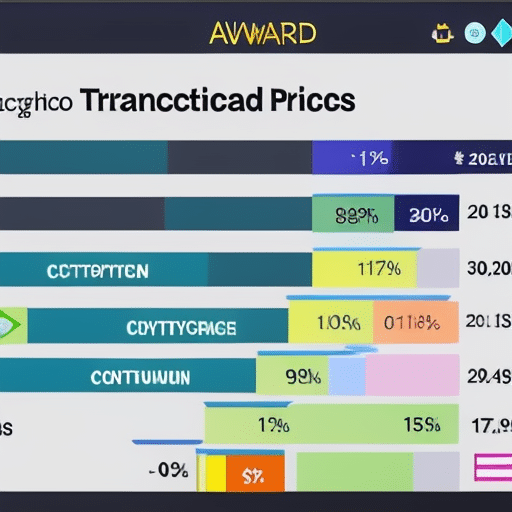Xrp’s Role In International Trade
Ripple’s XRP has gained significant traction in recent years, particularly in the field of international trade. As a digital asset, XRP is seen as an improvement over existing traditional methods of transferring value across borders. This article will explore how XRP can benefit international traders and its potential to disrupt the banking system. It will examine the advantages that come with using XRP for cross-border payments and reducing foreign exchange risk. Additionally, it will discuss the challenges facing XRP and investigate its potential benefits for investors. Finally, this article will look into how banks may benefit from adopting XRP technology. By doing so, this article seeks to provide a comprehensive overview of the role that XRP plays in international trade today.
The use of digital assets such as Ripple’s XRP has become increasingly popular for facilitating global transactions due to its fast transaction times and cost-effectiveness compared to traditional methods like wire transfers or credit cards. It also provides users with more control over their financial data by allowing them to track their payments easily without relying on third parties like banks or payment processors. Furthermore, since it runs on distributed ledger technology (DLT), it offers greater security than other forms of payments which is especially beneficial when dealing with large sums of money across different jurisdictions or currencies. All these factors make XRP a promising solution for international traders looking to increase efficiency and reduce costs while trading across borders.
Overview of XRP
Ripple (XRP) is a cryptocurrency designed to facilitate international payments with increased speed and efficiency compared to traditional methods. It operates within the Ripple network, which is built on a distributed ledger technology that enables fast and secure transactions. Unlike other cryptocurrencies, XRP offers both centralized and decentralized advantages. The decentralized aspect allows for improved scalability and lower transaction costs while the centralized part provides more control over regulation of the currency, allowing it to be adopted by governments or financial institutions. This combination of features makes XRP an attractive option for international payments due to its potential compliance with national currencies regulations as well as its shared access across multiple countries. Moreover, its ability to quickly process large amounts of money makes it ideal for global transfers in comparison with current banking systems. As such, XRP has become a viable solution for facilitating trade across borders without relying on traditional payment methods such as wire transfers or credit cards. In conclusion, XRP’s unique blend of decentralization and regulation make it an appealing choice for international trade operations.
Benefits of XRP for International Trade
XRP (Ripple) has emerged as a popular choice among international traders due to its many advantages. The platform enables faster transaction times compared to traditional banking methods, while also offering lower fees and increased transparency. Additionally, XRP provides improved security through the use of blockchain technology, allowing users to securely send and receive payments with greater assurance. These features make XRP an attractive option for those involved in global trade.
Faster Transaction Times
Utilizing blockchain technology, Ripple offers a faster transaction time than traditional methods of international trade. This is due to the distributed ledger that allows for near-instantaneous settlements. With faster transactions, companies can quickly react to market shifts and take advantage of opportunities that were not available before. The benefits of faster transactions include:
- Reducing fraud – Transactions are verified on the blockchain, making it significantly more difficult for fraudulent activity or double spending to occur.
- Automating payments – Smart contracts can be created between two parties to ensure secure and instant payments with no need for an intermediary.
- Increased liquidity – Funds are immediately available after a transaction has been made which increases liquidity and reduces processing costs.
This increase in efficiency and speed provided by XRP results in cost savings for businesses, allowing them to invest their resources elsewhere such as developing new products or services or expanding into new markets. Additionally, quicker transactions lead to improved customer satisfaction as goods and services can be delivered faster with less delays caused by manual processing times. By shortening the payment cycle from days or weeks down to mere seconds, XRP is revolutionizing international trade through its fast transaction times.
Lower Transaction Fees
By offering lower transaction fees, Ripple enables businesses to save on costs while simultaneously increasing their global reach. The reduced volatility of XRP combined with the ability to hedge against fluctuating foreign currency exchange rates provide business owners with increased affordability and peace of mind when making international payments. Moreover, these cost-saving benefits can be further compounded by the decreased need for currency hedging due to the stability of XRP’s value. Even minor fluctuations in exchange rates can add up quickly over time, leading to significant savings for businesses that rely on international payments. The combination of low fees and stable value makes XRP a powerful tool for businesses looking for an affordable way to increase their global reach. As such, it is no surprise that many companies are turning towards this blockchain-based payment system as a means of reducing their costs and expanding their operations abroad. In addition to all these advantages, Ripple also provides increased transparency over transactions due to its immutable ledger technology, allowing users greater visibility into where money is going and how it is being used.
Increased Transparency
Ripple’s immutable ledger technology provides users with a level of transparency, allowing them to gain insight into the destination and purpose of their funds. This enhanced visibility allows for automated processing, which simplifies the process and decreases the risk associated with international trade. Additionally, this transparency helps ensure that payments are accurately logged in real-time, providing an accurate picture of a company’s financial status. With this improved visibility, businesses have greater control over their finances and can improve their security protocols to protect against fraudulent activities. As a result, XRP has become an attractive option for companies looking to streamline their international trade operations due to its increased transparency capabilities.
The increased transparency provided by XRP eliminates many common roadblocks associated with international trade such as delayed payments or inaccuracies in transfer amounts. By providing users with greater visibility into these transfers, they can take active steps towards ensuring accuracy and timely completion of transactions without worrying about potential issues arising from manual processing errors or fraud attempts. Moreover, this level of oversight further reduces operational costs by reducing time spent on reconciliations and other costly verification practices that could arise from manual processes. With this improved security comes greater peace of mind for companies engaging in global commerce operations involving XRP.
Improved Security
The enhanced visibility of transactions provided by XRP allows businesses to better protect their finances from fraudulent activities. The improved scalability and reliability of XRP allows for quicker transactions that can be completed more securely. This improved security offers several benefits, such as:
- Reduced risk of financial losses due to fraud or theft;
- Improved ability to track and trace payments, ensuring all parties involved are held accountable;
- Greater assurance that the funds sent will arrive in a timely manner with no delays or discrepancies.
As a result, the adoption of XRP in international trade is becoming increasingly attractive given its enhanced security features which protect against fraudulent activities whilst providing greater trust between transacting parties.
Adoption of XRP in International Trade
XRP’s adoption in international trade has seen a major uptake by major retailers, banks and financial institutions alike. As one of the most widely used digital currencies for cross-border payments, XRP has been adopted by many organisations as an efficient way to conduct transactions with lower costs and faster processing speeds. Banks are increasingly recognising its potential to revolutionise the global payment system while also providing a secure method of transferring money across borders. Financial institutions are integrating XRP into their existing networks due to its scalability and liquidity, which enables them to process payments quickly at a low cost.
Major Retailers
Substantial retail establishments have adopted XRP as a payment alternative in order to facilitate cross-border transactions. This is due to the fact that it offers an efficient and cost-effective way of completing international payments. Alternative methods, such as bank transfers, are often too slow and expensive for business purposes, making them unattractive options in comparison with XRP’s quick settlement times and low transaction fees. Furthermore, the use of XRP can also be applied to streamline the supply chain management processes by improving visibility of payments across borders and reducing potential delays due to lengthy paperwork.
By utilizing these capabilities of XRP, major retailers have been able to reduce costs associated with international trade while simultaneously increasing their global reach. With this newfound ability to conduct business with ease across different countries and currencies, organizations are now more willing than ever before to enter new markets abroad. As a result, XRP has become an indispensable tool for many retailers who wish to participate in international trade without having to worry about the complexities associated with traditional banking systems. Moving forward, it is likely that more companies will embrace XRP technology as a reliable way of conducting international transactions efficiently and cost-effectively.
Banks and Financial Institutions
Financial institutions are increasingly embracing XRP technology to facilitate global payments in an efficient and cost-effective manner. Ripple’s impact on centralized banking has been profound, as banks have realized the immense potential of using XRP for faster, more secure cross-border transactions. Many leading financial institutions have already partnered with Ripple to benefit from its blockchain technology, allowing them to make international payments quickly and securely. The ability of XRP to reduce transaction costs while increasing speed and security has been a major factor in driving adoption by banks and other financial institutions. With banks now recognizing the value of utilizing Ripple’s innovative solutions, it is clear that XRP is playing a crucial role in modernizing the traditional banking system and creating new opportunities for international trade. This shift towards greater use of XRP in global finance will likely result in increased efficiency and cost savings for both businesses and consumers when making cross-border payments.
XRP and Cross-Border Payments
The use of XRP as a payment method for cross-border payments has the potential to reduce payment risks, increase efficiency and reduce regulatory costs. The elimination of intermediary banks in such transactions through the use of XRP can help ensure that parties involved in international trade transactions are able to transact with increased security and reliability. Furthermore, the reduction of fees associated with intermediary banks could lead to significant cost savings for parties involved in cross-border payments, providing an incentive for adoption of XRP technology.
Reduction of Payment Risk
Risk management is essential for successful international trade, and the use of Ripple’s XRP cryptocurrency can significantly reduce payment risk. For starters, XRP eliminates the need for credit ratings in order to verify buyers and sellers prior to transacting. This removes a major source of risk associated with cross-border payments, as credit ratings are often unreliable or incomplete when dealing with customers from foreign countries. Additionally, XRP’s distributed ledger technology provides complete transparency into the transaction process so that buyers and sellers can easily review each other’s credentials before agreeing on a deal. Furthermore, XRP also allows users to set parameters such as time limits and transaction fees upfront which helps protect both parties from any unexpected costs. Lastly, XRP eliminates the need for third party intermediaries which reduces the cost and complexity of international transactions while also improving security.
In addition to reducing payment risk, XRP also increases efficiency in international trade by providing fast and secure transfers between different currencies at low costs. This makes it easier for businesses to access global markets without having to worry about exchange rate fluctuations or long delays in settlement times. By utilizing XRP’s blockchain technology coupled with its liquidity solutions, companies can streamline their payment processes resulting in an overall faster and smoother trading experience than traditional systems allow for. With these features combined together, it is clear that Ripple’s XRP cryptocurrency offers many advantages over existing methods of conducting cross-border payments thereby making it an ideal choice for those looking to reduce payment risk while increasing efficiency in international trade.
Increased Efficiency
Utilizing blockchain technology and liquidity solutions, Ripple’s cryptocurrency can facilitate faster and smoother payments between different currencies, thus increasing efficiency in the global marketplace. Automated settlement processes enable almost instantaneous transactions to occur, which shortens the time it takes for a transaction to be processed from days or weeks to a matter of seconds. This allows users to save money on fees associated with international payments, while also eliminating other problems such as exchange rate risk. Additionally, financial inclusion is increased due to Ripple providing access to its system to both formal and informal financial institutions – allowing those who do not have access to traditional banking services an opportunity for financial inclusion. As a result of this increased efficiency in international trade provided by Ripple’s XRP, all parties involved benefit from reduced payment risks and cost savings. Furthermore, this enhanced efficiency creates more opportunities for businesses worldwide that would otherwise not exist without these technological advancements. Transitioning into the subsequent section about reduction of regulatory costs, Ripple’s ability to facilitate rapid cross-border payments also has implications for reducing regulatory costs in international trade.
Reduction of Regulatory Costs
Ripple’s cryptocurrency solutions have the potential to greatly reduce regulatory costs in international payments, with estimates indicating that 50% of compliance costs could be reduced. One of the key benefits is the streamlining of regulations that can be achieved by using XRP as a bridge currency:
- Exchange rates are locked-in for both parties at the time of transaction, eliminating uncertainty and reducing risk exposure;
- Automated KYC/AML checks make it possible to assess customers quickly and accurately;
- Real-time cross-border payments mean no more waiting on intermediaries or clearinghouses;
- The ability to track and trace transactions from origin to destination helps provide transparency;
- Settlement is instantaneous, making reconciliation easier.
This reduction in regulatory costs associated with international transfers provides cost savings opportunities for businesses who use XRP. Furthermore, it opens up new possibilities for financial inclusion across borders by helping reduce friction points and fees associated with traditional banking systems. In turn, this enables a wider range of individuals and businesses to access global markets and transact freely without costly delays or prohibitive compliance requirements. With these advantages in mind, it is clear why XRP can help reduce foreign exchange risk when used in international trade.
How XRP Can Help Reduce Foreign Exchange Risk
By leveraging the quick settlement times and low transaction fees of XRP, international traders can reduce their exposure to foreign exchange risk. As currencies fluctuate in value, using a digital asset like XRP can help to mitigate the volatility of the market. Transactions with XRP are settled faster than traditional currency transfers and there is no third-party involvement, meaning that liquidity issues can be avoided. This reduces the need for traders to constantly monitor currency prices and hedge against potential losses due to sudden changes in market conditions. By reducing regulatory costs, transaction times, and risks associated with foreign exchange, XRP can be an invaluable tool in international trade. With these benefits in mind, it is clear that XRP may offer advantages for small businesses looking to expand their operations globally.
The Benefits of XRP for Small Businesses
Small businesses can benefit greatly from the use of XRP, as it provides an accessible gateway to a global market of customers and suppliers. It also helps to drive down costs and improve cash flow, by eliminating high transaction fees associated with international payments. Transactions on the XRP ledger are highly secure and fast, allowing for efficient processing of payments, which can help small businesses manage their finances more effectively without incurring additional costs.
Access to Global Markets
XRP has enabled access to global markets for entities of all sizes, allowing businesses to expand their reach and increase their opportunities for international commerce. This is due in part to the smart contracts and distributed ledger technology that XRP uses, which allows users to quickly and securely transact across borders without having to deal with exchange fees or long wait times. This opens up new opportunities for small businesses who may have previously been limited by geographic boundaries, as they can now access customers from anywhere in the world. Additionally, this also provides an additional layer of security as transactions are stored on a secure blockchain network, making it extremely difficult for fraudsters or hackers to gain unauthorized access.
The result of this increased access is reduced costs associated with international trade for both buyers and sellers. By eliminating middlemen such as banks or payment processors, XRP eliminates additional fees that would come with traditional methods of sending money abroad. Furthermore, its instantaneous transaction processing speed means companies can move funds quickly between different currencies without needing to convert them first into a single currency. This cost savings allows businesses to save time and resources while still accessing foreign markets on their own terms.
Cost Savings
Utilizing blockchain technology, XRP has enabled businesses of all sizes to significantly reduce costs associated with international transactions. By leveraging its faster processing speeds and cost-effective network fees, companies can streamline their transaction processes and maximize efficiency. While traditional methods of transferring money abroad often take days or even weeks to process, XRP transactions can be completed in mere seconds at a fraction of the cost. This allows for immediate access to funds and improved cash flow without incurring hefty bank fees on each transfer. As such, the use of XRP in international trade has become an increasingly attractive option to businesses looking to save time and money.
Improved Cash Flow
The cost savings associated with using XRP for international trade are significant, but the potential to improve cash flow is just as compelling. XRP provides businesses with access to a secure, reliable, and efficient platform for making cashless payments. This eliminates the need to pay large fees associated with traditional banking and financial services, such as wire transfers or foreign exchange transactions. Additionally, XRP enables risk mitigation by providing immediate liquidity when making cross-border payments. These features make it possible for companies to receive payment instantly without having to wait weeks or months for funds to arrive from overseas.
The advantages of using XRP can be seen in other aspects of international trade as well. These include increased customer satisfaction due to faster settlement times, reduced operational costs through automated processes, and improved scalability thanks to an open-source protocol that allows businesses around the world access to a single global network. All these factors indicate that XRP could revolutionize the way businesses handle their international transactions and potentially disrupt the entire financial industry. With its combination of cost savings and improved cash flow, XRP has become an attractive option for companies seeking reliable solutions for their global operations.
The Potential for XRP to Disrupt the Financial Industry
Recently, XRP has gained much attention for its potential to revolutionize the financial industry. Its distributed ledger technology allows for faster and cheaper international payments with a level of security and transparency that is unmatched in traditional methods. This can reduce the cost of regulatory compliance by streamlining processes, as well as provide greater data privacy due to the tamper-proof nature of XRP transactions. Furthermore, it allows for near-instantaneous cross-border payments, eliminating long delays between banks that are currently faced when transferring money overseas.
The advantages offered by XRP have led many experts to believe that it could disrupt the current banking system and pave the way for a new financial infrastructure built on blockchain technology. The potential implications of this shift are immense, ranging from reducing costs and improving operational efficiency to increasing liquidity in global markets. As such, it is likely that XRP will continue to be at the forefront of innovation in international finance and remain a key player in transforming how money moves around the world. With this in mind, it is clear that XRP has great potential to revolutionize international trade through remittances as well.
XRP and Remittances
The potential of XRP to disrupt the financial industry is immense, and its use in remittances is no exception. Remittances are money transfers made from one person or entity to another across international borders, often sent by individuals working abroad back to their home country. XRP has been cited as a potential solution for reducing the cost associated with sending remittance payments due to its global acceptance and fast settlement times. As an added bonus, it provides anonymity which can be beneficial for those wishing to keep their transactions private.
However, privacy concerns have been raised when using XRP for remittance payments due to its lack of regulation when compared with traditional banking systems and other digital payment networks such as PayPal. Despite this, many organizations are beginning to explore XRP’s potential as a means of faster and more secure international money transfers that could save both time and money for users worldwide. This transition into exploring the role of XRP in terms of modern-day money transfer platforms sets the stage for further discussion on this topic.
XRP and Money Transfer Platforms
Recent developments in financial technology have opened up possibilities for remittance payments to be made more quickly and securely than ever before, with XRP playing a significant part in these transfer platforms. Money transfer platforms leveraging XRP offer real time tracking of funds transferred, as well as decentralised control over the entire process. The transparency and efficiency that these features provide are key advantages when compared to traditional methods of remittance payments. Furthermore, these benefits can be achieved at a drastically reduced cost compared to other services available on the market today. This makes XRP an attractive choice for those looking to send money internationally in a safe and secure way. The potential of such payment solutions to revolutionise international trade is huge, making it an important factor in the future of global finance.
XRP and the Future of International Trade
As decentralised banking and remittance solutions become increasingly prevalent, XRP is set to play a crucial part in revolutionising the global payments landscape. As a digital asset designed to facilitate international payments, XRP offers several advantages over traditional payment systems such as faster transactions with lower fees. Additionally, its distributed ledger technology provides greater data privacy compared to traditional banking systems while also providing liquidity provision for those engaging in cross-border transactions. Overall, XRP has the potential to drastically reduce the time and cost associated with international trade which could lead to more efficient global markets and increased economic activity on an international level. With these benefits in mind, it is clear that XRP will be instrumental in shaping the future of international trade and finance. The challenges facing its adoption are significant but if overcome, this technology could have far-reaching implications for global commerce.
Challenges Facing XRP
XRP has the potential to revolutionize international trade, but there are a number of key challenges that must first be addressed. Regulatory issues have been an ongoing challenge for XRP, and there is still much uncertainty surrounding its legal status in various countries. This has made it difficult for companies to use XRP as a payment protocol without risking regulatory scrutiny. Additionally, scalability issues remain an issue for XRP, which can limit its effectiveness for certain applications. In order to become a viable option for international trade going forward, solutions must be found to these problems that will allow companies and individuals to use XRP with confidence.
To further complicate matters, investors need assurance that their investments in XRP are secure and will generate returns over time. Consequently, understanding the benefits of investing in XRP is essential before committing any funds.
The Benefits of XRP for Investors
Investing in XRP offers a variety of potential advantages for investors looking to diversify their portfolios and capitalize on the growing digital asset industry.
First, XRP can potentially facilitate increased liquidity and provide better access to capital markets. By opening up the market to more investors, XRP could help increase market efficiency, which is likely appealing to any investor. Additionally, XRP could offer improved scalability compared to traditional banking systems. This means that it could process transactions faster and for less cost than what would be required by traditional banking networks. Lastly, because of its innovative technology and potential applications in international trade, there may be a greater demand for XRP among investors looking for high growth opportunities.
These benefits make investing in XRP an attractive option for many investors who are seeking diversification or higher returns on their investments. The increased liquidity and scalability issues associated with this asset class could potentially open up new opportunities for those wishing to invest in digital assets. With these factors considered, it is easy to see why investing in XRP might be beneficial for those looking at the long-term prospects of this technology as well as its potential to disrupt the banking system.
The Potential for XRP to Disrupt the Banking System
XRP has the potential to revolutionize the banking system by providing a faster and more cost-effective means of conducting financial transactions. By utilizing cryptocurrency, XRP can offer banks a decentralized platform for making payments on an international scale, without having to rely on traditional methods like correspondent banking or SWIFT. This would reduce the need for multiple intermediaries, resulting in lower processing fees and quicker settlement times. Additionally, XRP could be used as an alternative currency for cross-border transfers, helping to reduce foreign exchange costs and increasing liquidity in global markets. The decentralization of operations also provides more security as it removes the risk of single points of failure due to centralization. As such, XRP has great potential to disrupt existing banking systems and create new opportunities for investors worldwide. These benefits make XRP a desirable asset class for many banks looking to expand their services and tap into new markets.
The Benefits of XRP for Banks
By leveraging the power of cryptocurrency, XRP offers banks a number of compelling benefits, such as reduced fees and faster settlement times, akin to opening a window into global markets. The technology behind XRP has opened up numerous opportunities for financial institutions around the world. Transactions settle four times faster than Bitcoin, making it an attractive option for banks dealing with large-scale remittances. Furthermore, the use of XRP could potentially reduce the cost of international payments by up to 60%, meaning that unbanked populations in developing countries can benefit from more accessible digital banking solutions. This is especially important in regions where traditional banking systems are not well established or fail to provide reliable services due to high costs or lack of infrastructure. With its fast transaction speeds and low fees, XRP promises to revolutionize international trade by providing an efficient and cost-effective way for banks to move money across borders.






 Bitcoin
Bitcoin  Ethereum
Ethereum  Tether
Tether  XRP
XRP  USDC
USDC  Wrapped SOL
Wrapped SOL  TRON
TRON  Lido Staked Ether
Lido Staked Ether  Dogecoin
Dogecoin  Figure Heloc
Figure Heloc  Cardano
Cardano  WhiteBIT Coin
WhiteBIT Coin  Bitcoin Cash
Bitcoin Cash  Wrapped stETH
Wrapped stETH  Wrapped Bitcoin
Wrapped Bitcoin  USDS
USDS  Wrapped eETH
Wrapped eETH  Binance Bridged USDT (BNB Smart Chain)
Binance Bridged USDT (BNB Smart Chain)  Chainlink
Chainlink  Monero
Monero  LEO Token
LEO Token  WETH
WETH  Zcash
Zcash  Stellar
Stellar  Coinbase Wrapped BTC
Coinbase Wrapped BTC  Ethena USDe
Ethena USDe  Hyperliquid
Hyperliquid  Litecoin
Litecoin  Sui
Sui  Avalanche
Avalanche  Hedera
Hedera  sUSDS
sUSDS  Shiba Inu
Shiba Inu  Dai
Dai  USDT0
USDT0  Canton
Canton  Toncoin
Toncoin  PayPal USD
PayPal USD  World Liberty Financial
World Liberty Financial  Uniswap
Uniswap  Cronos
Cronos  Ethena Staked USDe
Ethena Staked USDe  Mantle
Mantle  USD1
USD1  Polkadot
Polkadot  Rain
Rain  Bitget Token
Bitget Token  MemeCore
MemeCore